您好,登錄后才能下訂單哦!
您好,登錄后才能下訂單哦!
本篇內容介紹了“Java Bean轉Map的坑怎么解決”的有關知識,在實際案例的操作過程中,不少人都會遇到這樣的困境,接下來就讓小編帶領大家學習一下如何處理這些情況吧!希望大家仔細閱讀,能夠學有所成!
有些業務場景下需要將 Java Bean 轉成 Map 再使用。
以為很簡單場景,但是坑很多。
import lombok.Data;
import java.util.Date;
@Data
public class MockObject extends MockParent{
private Integer aInteger;
private Long aLong;
private Double aDouble;
private Date aDate;
}父類
import lombok.Data;
@Data
public class MockParent {
private Long parent;
}將 Java Bean 轉 Map 最常見的手段就是使用 JSON 框架,如 fastjson 、 gson、jackson 等。 但使用 JSON 將 Java Bean 轉 Map 會導致部分數據類型丟失。 如使用 fastjson ,當屬性為 Long 類型但數字小于 Integer 最大值時,反序列成 Map 之后,將變為 Integer 類型。
maven 依賴:
<!-- https://mvnrepository.com/artifact/com.alibaba/fastjson --> <dependency> <groupId>com.alibaba</groupId> <artifactId>fastjson</artifactId> <version>2.0.8</version> </dependency>
示例代碼:
import com.alibaba.fastjson.JSON;
import com.alibaba.fastjson.TypeReference;
import java.util.Date;
import java.util.Map;
public class JsonDemo {
public static void main(String[] args) {
MockObject mockObject = new MockObject();
mockObject.setAInteger(1);
mockObject.setALong(2L);
mockObject.setADate(new Date());
mockObject.setADouble(3.4D);
mockObject.setParent(3L);
String json = JSON.toJSONString(mockObject);
Map<String,Object> map = JSON.parseObject(json, new TypeReference<Map<String,Object>>(){});
System.out.println(map);
}
}結果打印:
{"parent":3,"ADouble":3.4,"ALong":2,"AInteger":1,"ADate":1657299916477}
調試截圖:
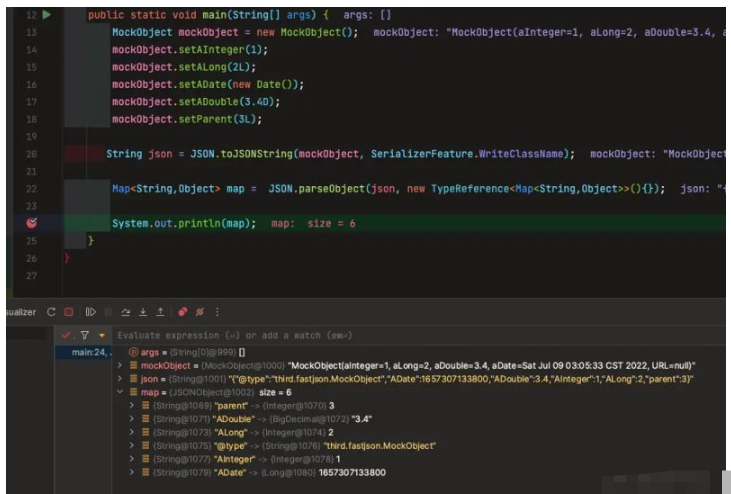
通過 Java Visualizer 插件進行可視化查看:
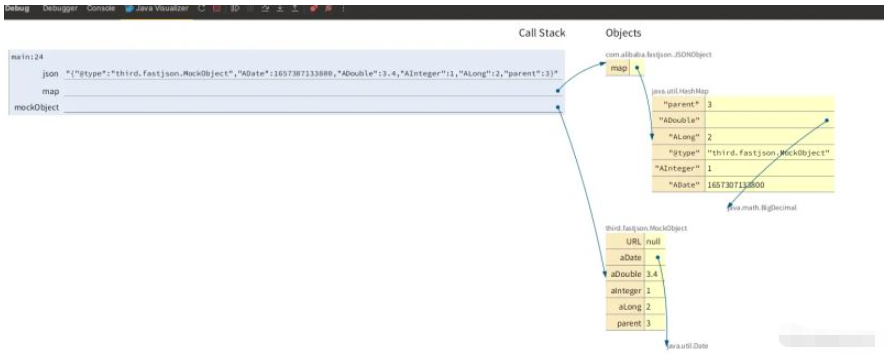
存在兩個問題 (1) 通過 fastjson 將 Java Bean 轉為 Map ,類型會發生轉變。 如 Long 變成 Integer ,Date 變成 Long, Double 變成 Decimal 類型等。 (2)在某些場景下,Map 的 key 并非和屬性名完全對應,像是通過 get set 方法“推斷”出來的屬性名。
maven 版本:
<!-- https://mvnrepository.com/artifact/commons-beanutils/commons-beanutils --> <dependency> <groupId>commons-beanutils</groupId> <artifactId>commons-beanutils</artifactId> <version>1.9.4</version> </dependency>
代碼示例:
import org.apache.commons.beanutils.BeanMap;
import third.fastjson.MockObject;
import java.util.Date;
public class BeanUtilsDemo {
public static void main(String[] args) {
MockObject mockObject = new MockObject();
mockObject.setAInteger(1);
mockObject.setALong(2L);
mockObject.setADate(new Date());
mockObject.setADouble(3.4D);
mockObject.setParent(3L);
BeanMap beanMap = new BeanMap(mockObject);
System.out.println(beanMap);
}
}調試截圖:
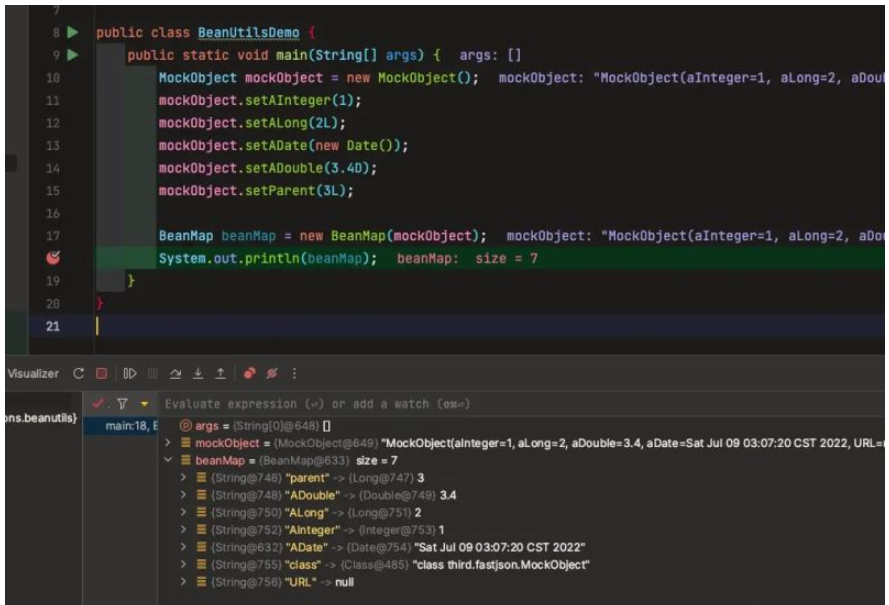
存在和 cglib 一樣的問題,雖然類型沒問題但是屬性名還是不對。
原因分析:
/**
* Constructs a new <code>BeanMap</code> that operates on the
* specified bean. If the given bean is <code>null</code>, then
* this map will be empty.
*
* @param bean the bean for this map to operate on
*/
public BeanMap(final Object bean) {
this.bean = bean;
initialise();
}關鍵代碼:
private void initialise() {
if(getBean() == null) {
return;
}
final Class<? extends Object> beanClass = getBean().getClass();
try {
//BeanInfo beanInfo = Introspector.getBeanInfo( bean, null );
final BeanInfo beanInfo = Introspector.getBeanInfo( beanClass );
final PropertyDescriptor[] propertyDescriptors = beanInfo.getPropertyDescriptors();
if ( propertyDescriptors != null ) {
for (final PropertyDescriptor propertyDescriptor : propertyDescriptors) {
if ( propertyDescriptor != null ) {
final String name = propertyDescriptor.getName();
final Method readMethod = propertyDescriptor.getReadMethod();
final Method writeMethod = propertyDescriptor.getWriteMethod();
final Class<? extends Object> aType = propertyDescriptor.getPropertyType();
if ( readMethod != null ) {
readMethods.put( name, readMethod );
}
if ( writeMethod != null ) {
writeMethods.put( name, writeMethod );
}
types.put( name, aType );
}
}
}
}
catch ( final IntrospectionException e ) {
logWarn( e );
}
}調試一下就會發現,問題出在 BeanInfo 里面 PropertyDescriptor 的 name 不正確。
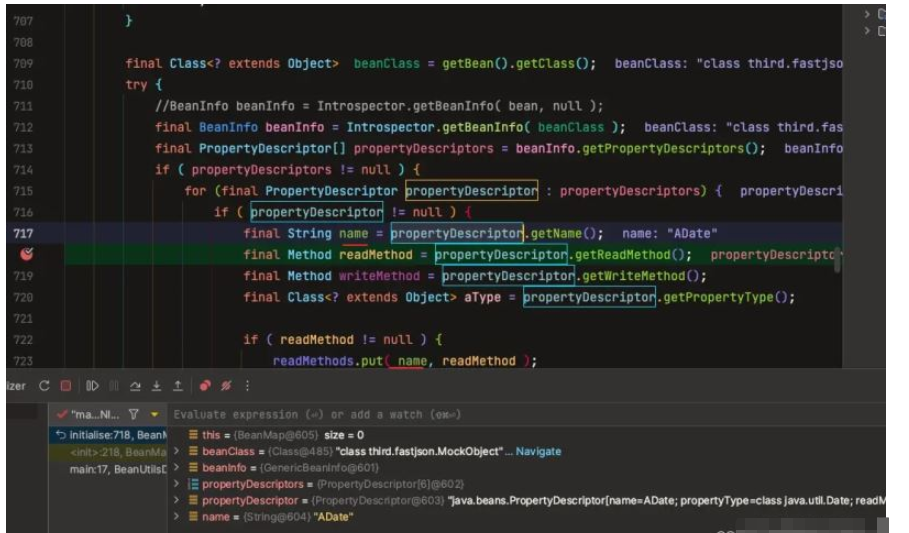
經過分析會發現 java.beans.Introspector#getTargetPropertyInfo 方法是字段解析的關鍵
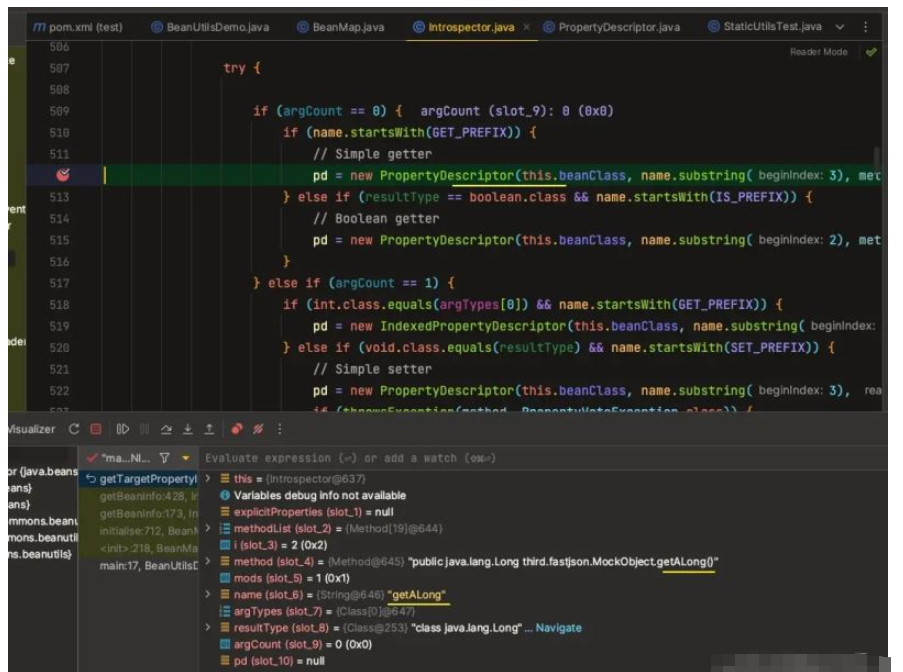
對于無參的以 get 開頭的方法名從 index =3 處截取,如 getALong 截取后為 ALong, 如 getADouble 截取后為 ADouble。
然后去構造 PropertyDescriptor:
/**
* Creates <code>PropertyDescriptor</code> for the specified bean
* with the specified name and methods to read/write the property value.
*
* @param bean the type of the target bean
* @param base the base name of the property (the rest of the method name)
* @param read the method used for reading the property value
* @param write the method used for writing the property value
* @exception IntrospectionException if an exception occurs during introspection
*
* @since 1.7
*/
PropertyDescriptor(Class<?> bean, String base, Method read, Method write) throws IntrospectionException {
if (bean == null) {
throw new IntrospectionException("Target Bean class is null");
}
setClass0(bean);
setName(Introspector.decapitalize(base));
setReadMethod(read);
setWriteMethod(write);
this.baseName = base;
}底層使用 java.beans.Introspector#decapitalize 進行解析:
/**
* Utility method to take a string and convert it to normal Java variable
* name capitalization. This normally means converting the first
* character from upper case to lower case, but in the (unusual) special
* case when there is more than one character and both the first and
* second characters are upper case, we leave it alone.
* <p>
* Thus "FooBah" becomes "fooBah" and "X" becomes "x", but "URL" stays
* as "URL".
*
* @param name The string to be decapitalized.
* @return The decapitalized version of the string.
*/
public static String decapitalize(String name) {
if (name == null || name.length() == 0) {
return name;
}
if (name.length() > 1 && Character.isUpperCase(name.charAt(1)) &&
Character.isUpperCase(name.charAt(0))){
return name;
}
char chars[] = name.toCharArray();
chars[0] = Character.toLowerCase(chars[0]);
return new String(chars);
}從代碼中我們可以看出 (1) 當 name 的長度 > 1,且第一個字符和第二個字符都大寫時,直接返回參數作為PropertyDescriptor name。 (2) 否則將 name 轉為首字母小寫
這種處理本意是為了不讓屬性為類似 URL 這種縮略詞轉為 uRL ,結果“誤傷”了我們這種場景。
cglib 依賴
<!-- https://mvnrepository.com/artifact/cglib/cglib --> <dependency> <groupId>cglib</groupId> <artifactId>cglib-nodep</artifactId> <version>3.2.12</version> </dependency>
代碼示例:
import net.sf.cglib.beans.BeanMap;
import third.fastjson.MockObject;
import java.util.Date;
public class BeanMapDemo {
public static void main(String[] args) {
MockObject mockObject = new MockObject();
mockObject.setAInteger(1);
mockObject.setALong(2L);
mockObject.setADate(new Date());
mockObject.setADouble(3.4D);
mockObject.setParent(3L);
BeanMap beanMapp = BeanMap.create(mockObject);
System.out.println(beanMapp);
}
}結果展示:
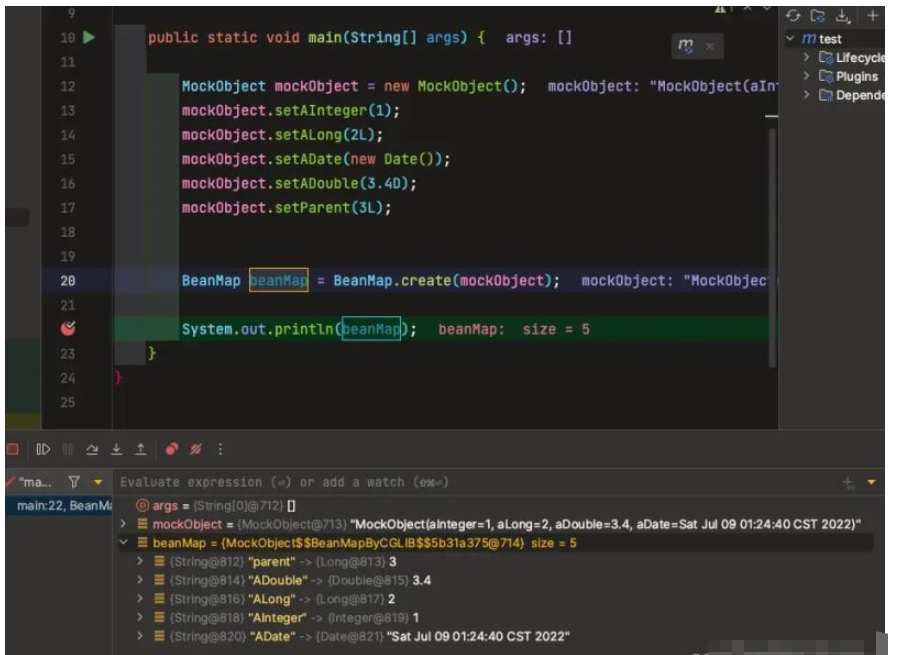
我們發現類型對了,但是屬性名依然不對。
關鍵代碼: net.sf.cglib.core.ReflectUtils#getBeanGetters 底層也會用到 java.beans.Introspector#decapitalize 所以屬性名存在一樣的問題就不足為奇了。
解決方案有很多,本文提供一個基于 dubbo的解決方案。
maven 依賴:
<!-- https://mvnrepository.com/artifact/org.apache.dubbo/dubbo --> <dependency> <groupId>org.apache.dubbo</groupId> <artifactId>dubbo</artifactId> <version>3.0.9</version> </dependency>
示例代碼:
import org.apache.dubbo.common.utils.PojoUtils;
import third.fastjson.MockObject;
import java.util.Date;
public class DubboPojoDemo {
public static void main(String[] args) {
MockObject mockObject = new MockObject();
mockObject.setAInteger(1);
mockObject.setALong(2L);
mockObject.setADate(new Date());
mockObject.setADouble(3.4D);
mockObject.setParent(3L);
Object generalize = PojoUtils.generalize(mockObject);
System.out.println(generalize);
}
}調試效果:
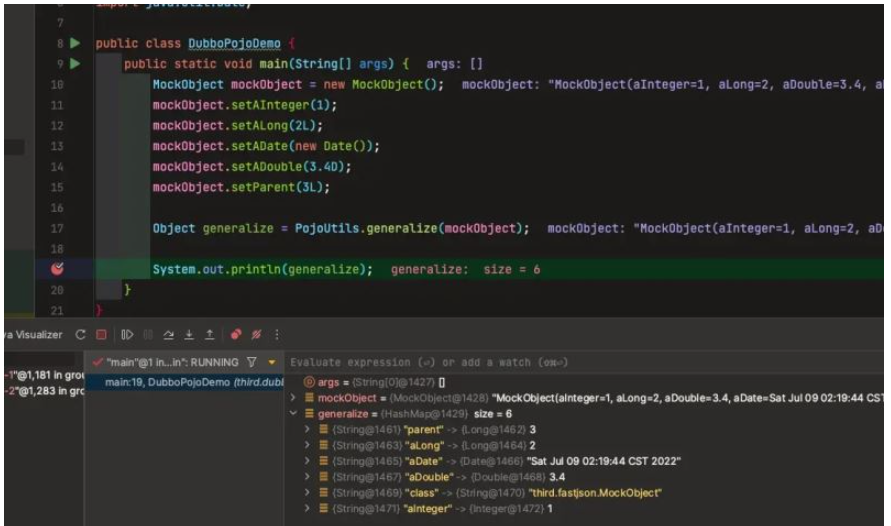
Java Visualizer 效果:
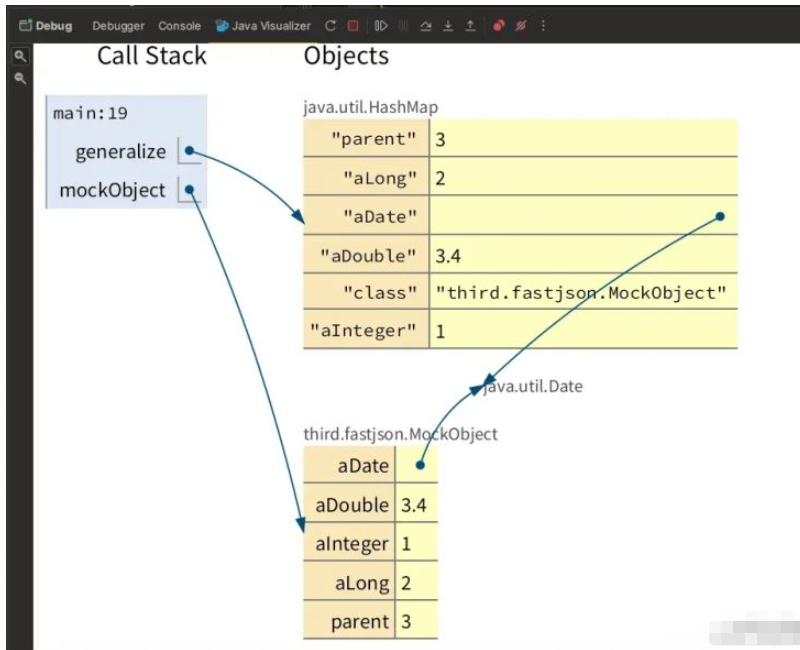
大家可以下載源碼來簡單研究下。 github.com/apache/dubb…
核心代碼: org.apache.dubbo.common.utils.PojoUtils#generalize(java.lang.Object)
public static Object generalize(Object pojo) {
eturn generalize(pojo, new IdentityHashMap());
}關鍵代碼:
// pojo 待轉換的對象
// history 緩存 Map,提高性能
private static Object generalize(Object pojo, Map<Object, Object> history) {
if (pojo == null) {
return null;
}
// 枚舉直接返回枚舉名
if (pojo instanceof Enum<?>) {
return ((Enum<?>) pojo).name();
}
// 枚舉數組,返回枚舉名數組
if (pojo.getClass().isArray() && Enum.class.isAssignableFrom(pojo.getClass().getComponentType())) {
int len = Array.getLength(pojo);
String[] values = new String[len];
for (int i = 0; i < len; i++) {
values[i] = ((Enum<?>) Array.get(pojo, i)).name();
}
return values;
}
// 基本類型返回 pojo 自身
if (ReflectUtils.isPrimitives(pojo.getClass())) {
return pojo;
}
// Class 返回 name
if (pojo instanceof Class) {
return ((Class) pojo).getName();
}
Object o = history.get(pojo);
if (o != null) {
return o;
}
history.put(pojo, pojo);
// 數組類型,遞歸
if (pojo.getClass().isArray()) {
int len = Array.getLength(pojo);
Object[] dest = new Object[len];
history.put(pojo, dest);
for (int i = 0; i < len; i++) {
Object obj = Array.get(pojo, i);
dest[i] = generalize(obj, history);
}
return dest;
}
// 集合類型遞歸
if (pojo instanceof Collection<?>) {
Collection<Object> src = (Collection<Object>) pojo;
int len = src.size();
Collection<Object> dest = (pojo instanceof List<?>) ? new ArrayList<Object>(len) : new HashSet<Object>(len);
history.put(pojo, dest);
for (Object obj : src) {
dest.add(generalize(obj, history));
}
return dest;
}
// Map 類型,直接 對 key 和 value 處理
if (pojo instanceof Map<?, ?>) {
Map<Object, Object> src = (Map<Object, Object>) pojo;
Map<Object, Object> dest = createMap(src);
history.put(pojo, dest);
for (Map.Entry<Object, Object> obj : src.entrySet()) {
dest.put(generalize(obj.getKey(), history), generalize(obj.getValue(), history));
}
return dest;
}
Map<String, Object> map = new HashMap<String, Object>();
history.put(pojo, map);
// 開啟生成 class 則寫入 pojo 的class
if (GENERIC_WITH_CLZ) {
map.put("class", pojo.getClass().getName());
}
// 處理 get 方法
for (Method method : pojo.getClass().getMethods()) {
if (ReflectUtils.isBeanPropertyReadMethod(method)) {
ReflectUtils.makeAccessible(method);
try {
map.put(ReflectUtils.getPropertyNameFromBeanReadMethod(method), generalize(method.invoke(pojo), history));
} catch (Exception e) {
throw new RuntimeException(e.getMessage(), e);
}
}
}
// 處理公有屬性
for (Field field : pojo.getClass().getFields()) {
if (ReflectUtils.isPublicInstanceField(field)) {
try {
Object fieldValue = field.get(pojo);
// 對象已經解析過,直接從緩存里讀提高性能
if (history.containsKey(pojo)) {
Object pojoGeneralizedValue = history.get(pojo);
// 已經解析過該屬性則跳過(如公有屬性,且有 get 方法的情況)
if (pojoGeneralizedValue instanceof Map
&& ((Map) pojoGeneralizedValue).containsKey(field.getName())) {
continue;
}
}
if (fieldValue != null) {
map.put(field.getName(), generalize(fieldValue, history));
}
} catch (Exception e) {
throw new RuntimeException(e.getMessage(), e);
}
}
}
return map;
}關鍵截圖
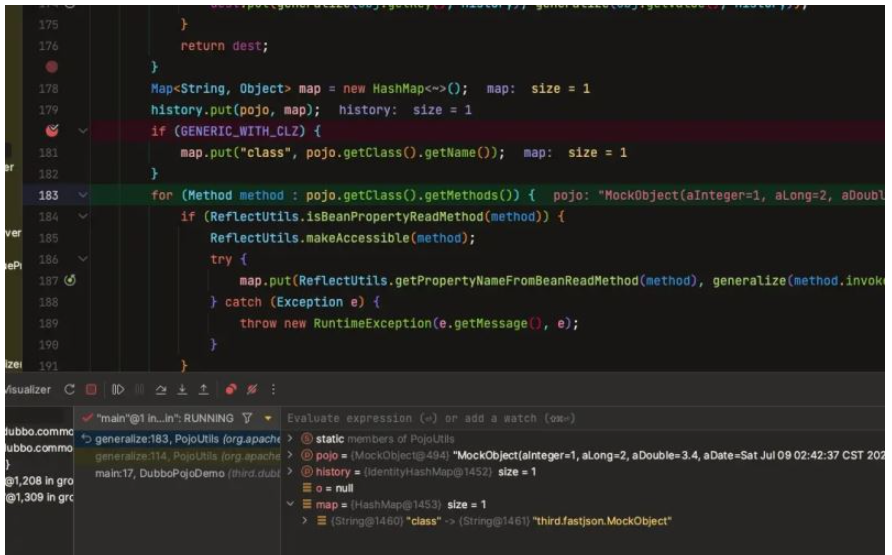
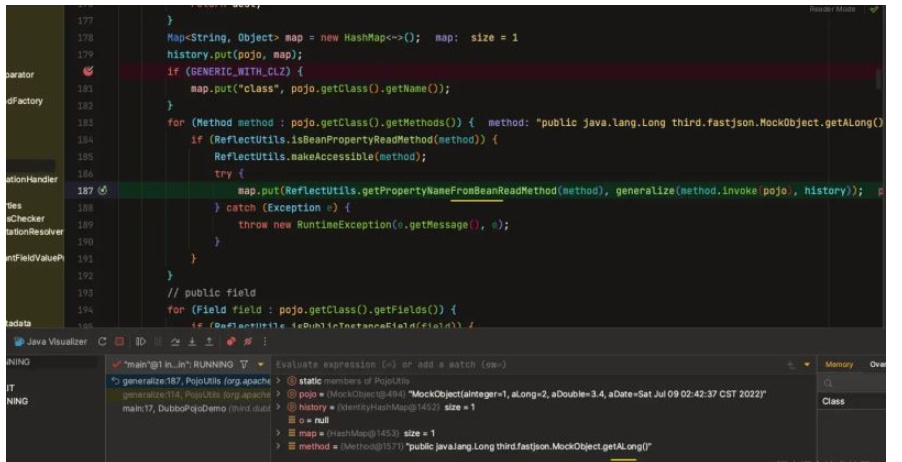
org.apache.dubbo.common.utils.ReflectUtils#getPropertyNameFromBeanReadMethod
public static String getPropertyNameFromBeanReadMethod(Method method) {
if (isBeanPropertyReadMethod(method)) {
// get 方法,則從 index =3 的字符小寫 + 后面的字符串
if (method.getName().startsWith("get")) {
return method.getName().substring(3, 4).toLowerCase()
+ method.getName().substring(4);
}
// is 開頭方法, index =2 的字符小寫 + 后面的字符串
if (method.getName().startsWith("is")) {
return method.getName().substring(2, 3).toLowerCase()
+ method.getName().substring(3);
}
}
return null;
}因此, getALong 方法對應的屬性名被解析為 aLong。
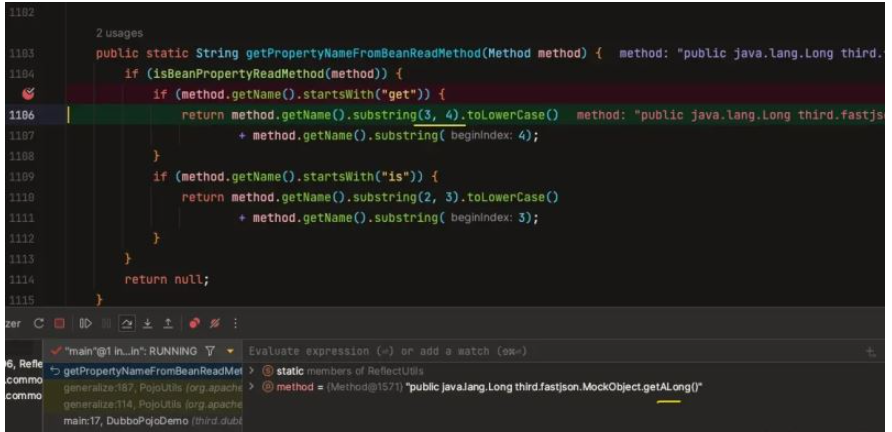
同時,這么處理也會存在問題。如當屬性名叫 URL 時,轉為 Map 后 key 就會被解析成 uRL。
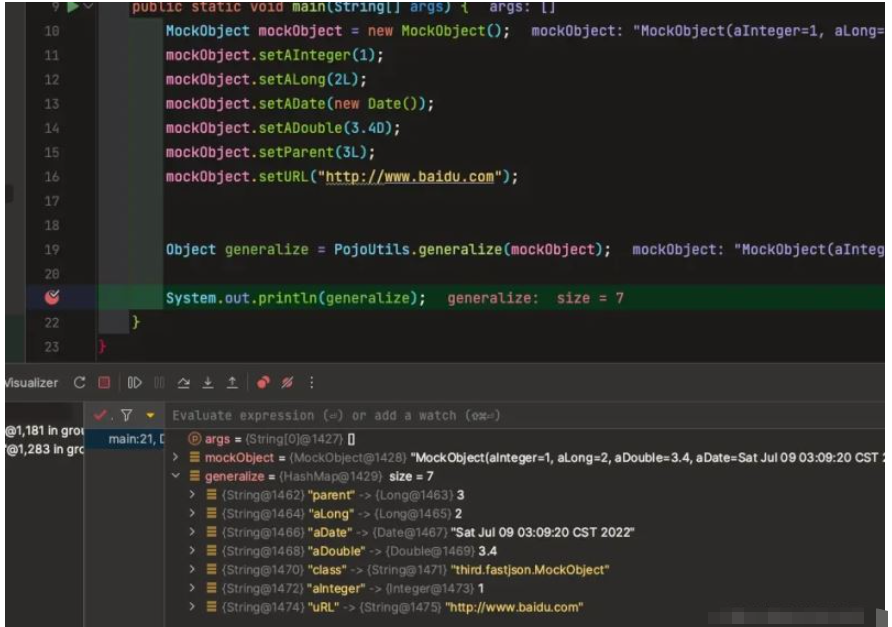
從這里看出,當屬性名比較特殊時也很容易出問題,但 dubbo 這個工具類更符合我們的預期。 如果想嚴格和屬性保持一致,可以使用反射獲取屬性名和屬性值,加緩存機制提升解析的效率。
“Java Bean轉Map的坑怎么解決”的內容就介紹到這里了,感謝大家的閱讀。如果想了解更多行業相關的知識可以關注億速云網站,小編將為大家輸出更多高質量的實用文章!
免責聲明:本站發布的內容(圖片、視頻和文字)以原創、轉載和分享為主,文章觀點不代表本網站立場,如果涉及侵權請聯系站長郵箱:is@yisu.com進行舉報,并提供相關證據,一經查實,將立刻刪除涉嫌侵權內容。